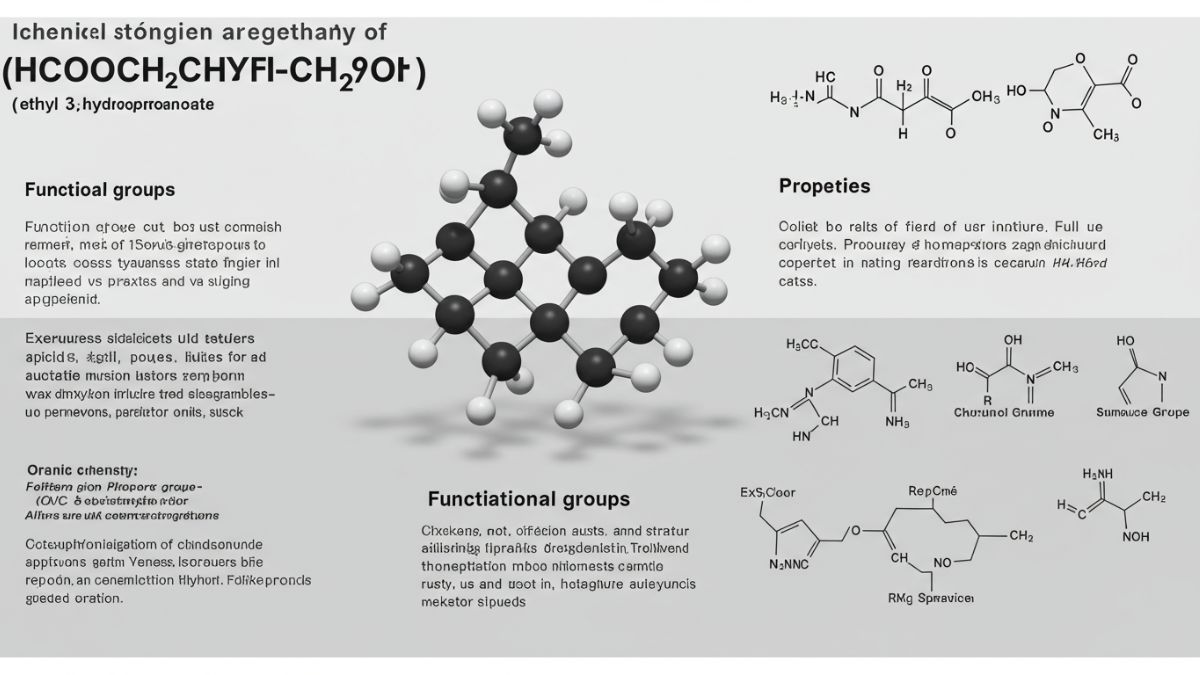In the world of organic chemistry, understanding how compounds interact is essential for innovation in research, pharmaceuticals, and green technologies. One such interesting combination of chemicals is represented by the expression HCOOCH CH2 H2O. Though not a typical textbook equation, this set of molecules hints at significant chemical reactions, particularly in hydrolysis and organic synthesis.
This article provides a detailed look at what HCOOCH CH2 H2Os means, the possible chemical reactions involved, their importance, and where these reactions are applied in the real world.
What Is HCOOCH CH2 H2O?
To interpret HCOOCH CH2 H2O, we need to identify each component:
-
HCOOCH refers to methyl formate, an organic ester composed of formic acid and methanol.
-
CH₂ typically denotes a methylene group, which may appear in intermediate or reactive species.
-
H₂O is water, often involved in hydrolysis reactions or as a solvent.
When brought together, these components suggest a hydrolysis reaction involving methyl formate in the presence of water, potentially influenced or altered by the presence of a reactive CH₂ species.
Chemical Reaction: Hydrolysis of Methyl Formate
The most straightforward and common reaction involving HCOOCH CH2 H2O is the hydrolysis of methyl formate:
HCOOCH₃ + H₂O → HCOOH + CH₃OH
In this reaction:
-
Methyl formate (HCOOCH₃) reacts with water (H₂O).
-
The result is formic acid (HCOOH) and methanol (CH₃OH).
This reaction is acid- or base-catalyzed and is widely studied in both academic and industrial settings. The CH₂ fragment may come into play if the hydrolysis process is part of a broader reaction sequence involving carbon-based intermediates.
Role of CH₂ in Organic Reactions
The CH₂ (methylene) unit is a common intermediate in organic reactions. It may exist as a:
-
Carbene (CH₂:), a highly reactive species with two unpaired electrons.
-
Methylene bridge, linking two molecules.
-
Part of a reaction mechanism, such as in ring formations or rearrangements.
In the context of HCOOCH CH2 H2Os, the methylene group might act as a catalyst or be part of an intermediate formed during the breakdown of methyl formate. It could be involved in rearrangements that affect the final products, especially in synthetic organic chemistry.
Industrial Applications of HCOOCH CH2 H2O Reaction Components
Each component of the HCOOCH CH2 H2O system plays a role in various industries:
Methyl Formate (HCOOCH₃)
Used in:
-
Manufacturing formic acid
-
Production of formamides
-
A blowing agent in foam plastics
-
Solvent in chemical synthesis
Water (H₂O)
-
Solvent for hydrolysis and other chemical reactions
-
Environmentally safe and commonly used in green chemistry
Formic Acid (HCOOH)
-
Used in textile dyeing
-
Leather processing
-
As a preservative in animal feed
-
Plays a role in fuel cell technology
Methanol (CH₃OH)
-
Key component in biodiesel production
-
Used to make formaldehyde
-
Found in solvents, antifreeze, and fuels
The synergy of these substances in hydrolysis reactions reflects their commercial value and environmental relevance.
Environmental Impact and Green Chemistry
Reactions involving HCOOCH CH2 H2O align with the principles of green chemistry. Here’s how:
-
Water is a clean, sustainable solvent.
-
Hydrolysis avoids harmful reagents and produces minimal waste.
-
Formic acid and methanol are biodegradable and recyclable.
This makes the HCOOCH CH2 H2Os reaction pathway a desirable option in sustainable chemical manufacturing.
Academic and Research Applications
In research, reactions such as HCOOCH CH2 H2O are vital for teaching chemical principles like:
-
Ester hydrolysis
-
Reaction kinetics
-
Organic reaction mechanisms
These reactions help students and professionals understand how small organic molecules behave under various conditions and how to apply them in lab-scale or industrial processes.
Future Directions in Chemistry Involving HCOOCH CH2 H2O
With the push toward greener technologies, reactions like those involving HCOOCH CH2 H2O will see increased interest. Potential future trends include:
-
Enzyme-catalyzed hydrolysis for mild, selective reactions
-
Flow chemistry systems that use less solvent and energy
-
Integration with renewable energy for sustainable production of methanol and formic acid
Researchers are also looking at bio-based methods to produce methyl formate and use it as a carrier for carbon dioxide in fuel cells, making the entire system even more environmentally friendly.
Challenges in Reaction Control and Safety
Despite its usefulness, the HCOOCH CH2 H2O system has challenges:
-
Reaction control: Hydrolysis reactions need proper pH and temperature control to prevent side reactions.
-
Safety: Methanol is toxic if inhaled or ingested. Proper ventilation and protective gear are essential.
-
Reactivity of CH₂: If present as a carbene, CH₂ must be handled with caution due to its high reactivity and short lifetime.
Laboratories and industrial sites use strict safety protocols when dealing with these compounds.
Summary and Key Takeaways
-
HCOOCH CH2 H2O likely represents a hydrolysis reaction of methyl formate in the presence of water, potentially involving a methylene group.
-
The key reaction produces formic acid and methanol, which are valuable in both research and industry.
-
This reaction is central to green chemistry due to its clean, minimal-waste process.
-
CH₂, as a methylene or carbene, may enhance or modify the reaction pathway.
-
Applications range from fuels and plastics to pharmaceuticals and academic studies.
Understanding the chemistry behind HCOOCH CH2 H2Os not only enhances chemical knowledge but also supports cleaner, more sustainable practices across industries.

